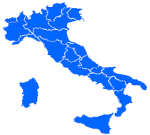|
||||||
General Info
| Introduction
Italy is a land celebrated for the arts, and not the least among the arts that have attained their highest expression in Italy is the art of hospitality. The Italian welcome is as warm and traditional as a glass of fine wine. This comparison is apt, for travelers in ancient times gave the country its first name: Land of Wines. Italians are such good hosts because they get so much practice welcoming visitors from all over the world.
Italy is one of the most popular vacation countries in Europe, all seasons being good for a visit. In summer, Italy is an international playground, with visitors from all continents mingling with vacationing Italians at the famous resorts. Spring comes early to Italy and autumn lingers - and so will the wise traveler who wants to enjoy at a more leisurely pace the art centers, the large cities and the holiday resorts such as those in the Lombardian lake region where spring and fall are ideal seasons.
In winter, the Italian Alps are unequaled for scenery and skiing. In northern Italy are some of the world's most renowned winter sports resorts, easily reached from such centers as Torino, chief city of the westernmost Piemonte region; from Milano, hub of the central mountain and lake district; and from Venezia, leading city of the eastern region. Skiing is also a summer sport in the Torino Alps and the lofty mountains surrounding the Valle d’Aosta. |
|
||||||||||||||||||||||||||||||||||||||||||||
|
Time
Holidays
list of National Statutory Holidays:
|
|||||||||||||||||||||||||||||||||||||||||||||
| Italy's Profile
Area:
116,303 square miles
|
|||||||||||||||||||||||||||||||||||||||||||||
Other important cities:
|
|||||||||||||||||||||||||||||||||||||||||||||
|
Geographical Profile
At the foot of the Alpine arc stretches the vast Po Valley plain, cut down the middle by the course of the river Po, the longest in Italy (390 miles), which has its source in the Pian de Re (Monviso) and flows into the Adriatic through a magnificent delta. The Alpine foothills are characterized by large lakes: Lake Maggiore and the lakes of Como, Iseo and Garda. The Apennines form the backbone of the peninsula, stretching in a wide arc concave to the Tyrrhenian Sea. The Corno Grande (Gran Sasso d'Italia) is the highest peak. A large part of central Italy is characterized by a green hilly landscape, through which the rivers Arno and Tevere (Tiber) run. The southern section of the chain pushes out to the east forming the Gargano promontory and, sloping down further south, the Salentine peninsula. It then proceeds to the west with the Calabrian and Peloritano massif stretching across the Strait of Messina into Sicilia. The principal islands are Sicilia, rising up to the great volcanic cone of Etna (10,860 feet) and Sardegna. The main archipelagos are the Tremiti Islands in the Adriatic Sea, the Tuscan Archipelago, the Pontine Islands, the Aeolian Islands and the Egadi Islands in the Tyrrhenian Sea off the coast of Sicilia. |
|||||||||||||||||||||||||||||||||||||||||||||


